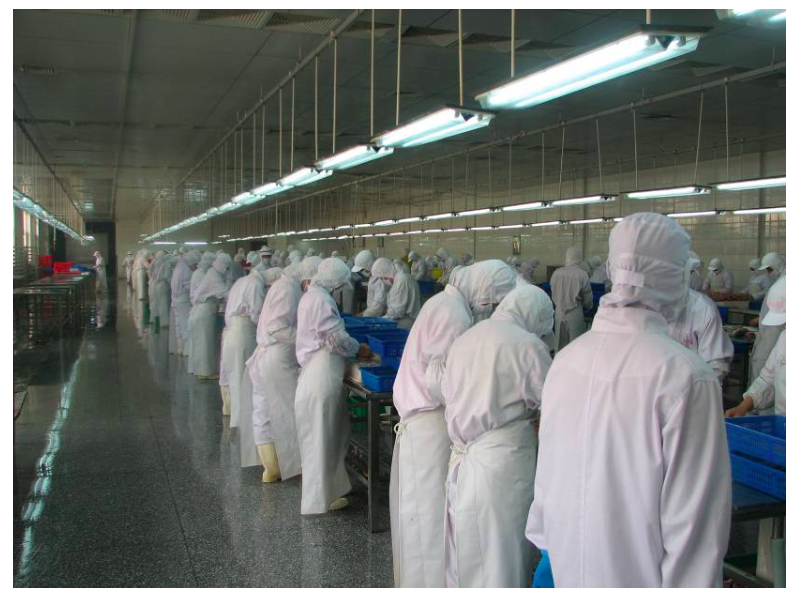Is Alaska seafood propping up the nuclear ambitions of North Korea’s Kim Jong Un?
According to a new report by the Associated Press, that is likely the case, as labor from North Korea is pervasive in the Chinese factories processing salmon and crab from the Northwest. That workforce has its wages largely skimmed off by the North Korean government. Forced labor is an important source of hard currency for the regime.
Because of the secrecy surrounding the labor force in the Chinese city bordering North Korea where seafood processing plants are located, the team of reporters were only able to partially verify that North Korean workers are, indeed, in the workforce.
Reporters observed portraits of North Korean leaders on worker dormitory walls, examined passports, identified the distinct accents of North Koreans, and interviewed numerous business persons in the Chinese city of Hunchun, on the border of North Korea.

The possibility of North Korean labor in the fisheries supply chain worries John Connelly, president of the National Fisheries Institute, enough that he is urging all of his associated companies to re-examine their supply chains “to ensure that wages go to the workers, and are not siphoned off to support a dangerous dictator.”
Of course, there would be no way a midsized company in Alaska could ever determine that North Koreans were picking bones out of pink salmon.
Facing growing imports of farmed seafood, Northwest processors have increasingly been shipping frozen, wild-caught Alaska salmon and Dungeness crab to China for processing. It returns to the U.S., Japan, or Europe and is purchased by consumers shopping the frozen section of grocery aisles.
How much Alaska seafood is being processed in China is hard to pin down, as Craig Medred explains.
Trident, for example, ships about 30 million pounds of its 1.2 billion-pound annual harvest to China for processing, which drives labor costs down by 80 percent.
NORTH KOREANS LABOR CONDITIONS IN CHINA
According to Radio Free Asia, North Korean workers sent to China are being forced to labor in unsafe conditions and are frequently deprived of part or all of their pay.
As many as 1,000 North Koreans work at a factory in Hunchun city in the “Yanbian Korean Autonomous Prefecture” in northeastern China’s Jilin province, the site reported two years ago.
Radio Free Asia, for which Sec. of State Rex Tillerson serves as a board member, reported that workers are not allowed to keep most of their salaries, but are given leftover seafood that they can take back to North Korea and sell, which provides them a source of income.
North Korean labor at the processing factories are giving over anywhere from half to 70 percent of their paychecks to the North Korean government, with workers making as little as $90 per month — or roughly 46 cents per hour for 12-hour days. Workers typically get one day off a week, according to Radio Free Asia.
“At some factories, laborers work hunched over tables as North Korean political slogans are blasted from waist-high loudspeakers,” the Associated Press reports.
AP named three seafood processors that employ North Koreans and export to the U.S.: Joint venture Hunchun Dongyang Seafood Industry & Trade Co. Ltd. & Hunchun Pagoda Industry Co. Ltd. distributed globally by Ocean One Enterprise; Yantai Dachen Hunchun Seafood Products, and Yanbian Shenghai Industry & Trade Co. Ltd.
The website for Ocean One says it mainly processes frozen and smoked salmon from Alaska and Hokkaido, Japan; squid from China and Argentina; cod and yellowfin sole from Alaska; and red fish from the North Atlantic.
In 2002 and 2001, Hunchun Export Processing Zone and Huichun Sino-Russia Trade Zone was established in Hunchun, which is strategically located between China, Russia and North Korea. The city’s focus is on seafood processing, electronic product manufacture, bio-pharmacy, and textiles.
China is Alaska’s largest seafood export market, accounting for 35 percent of tonnage and 27 percent of export value in 2015, according to a McDowell Group report.
The organization estimates that 80 to 90 percent of the exports to China are to processing factories that re-export the product to global markets.
“Most of Alaska’s exports to China consists of frozen H&G (headed/gutted) fish, which are then filleted in China where labor costs are considerably lower,” the report stated.
Alaska exported $1.2 billion in seafood, minerals, oil and other products to China in 2016, a quarter of the state’s exports.
GOVERNOR WALKER COURTS CHINA
Earlier this year, Gov. Bill Walker courted the Chinese government both in Alaska, and through a week-long junket that First Lady Donna Walker and her daughter and daughter-in-law took to China, fully funded by the Chinese government.


In September, Walker and an entourage of several from his administration traveled to China to market Alaska natural gas that Walker hopes will soon flow down a gas line he hopes to build, estimated to cost between $40-60 billion. Walker has made the gas line the cornerstone of his agenda as governor.

